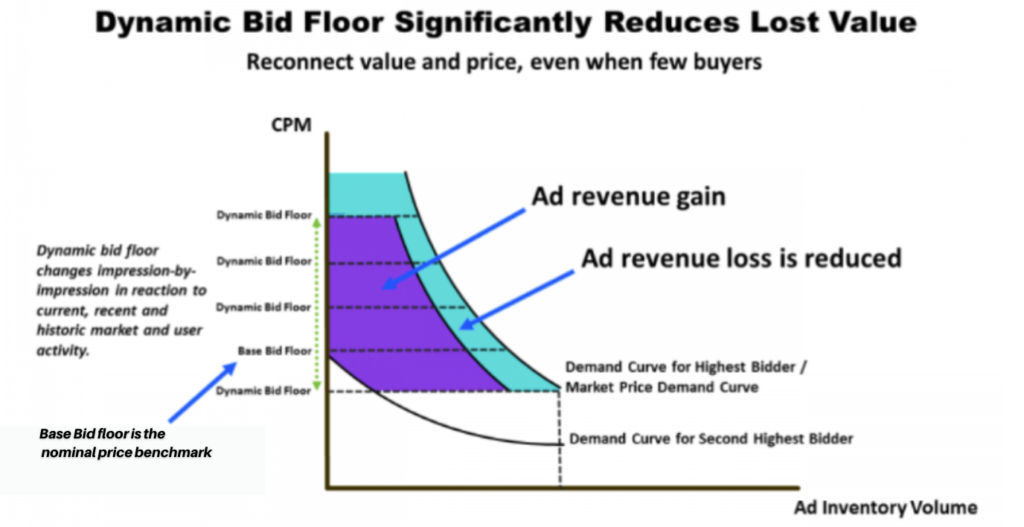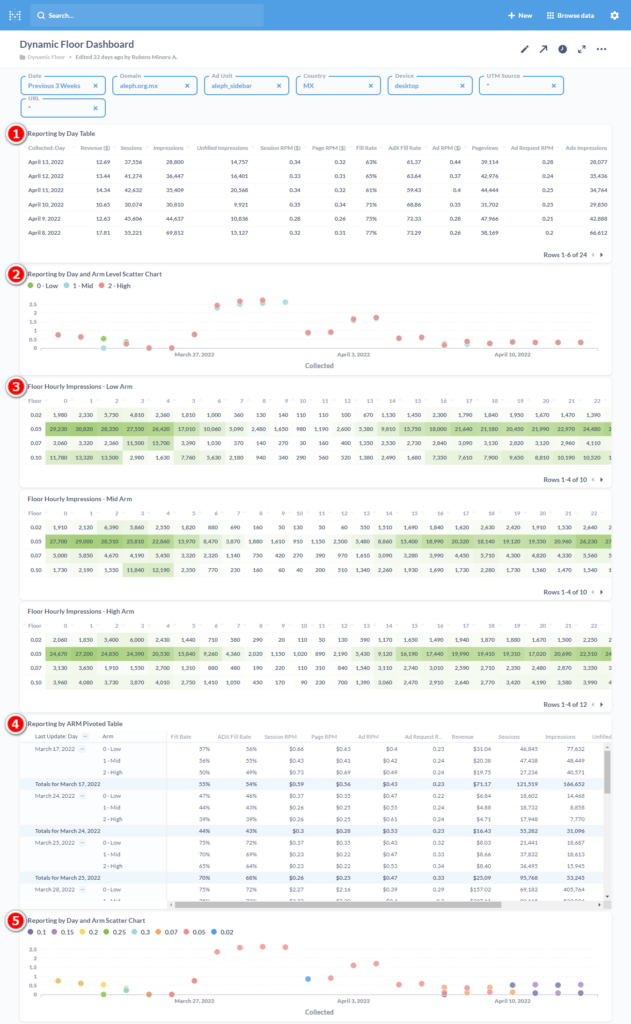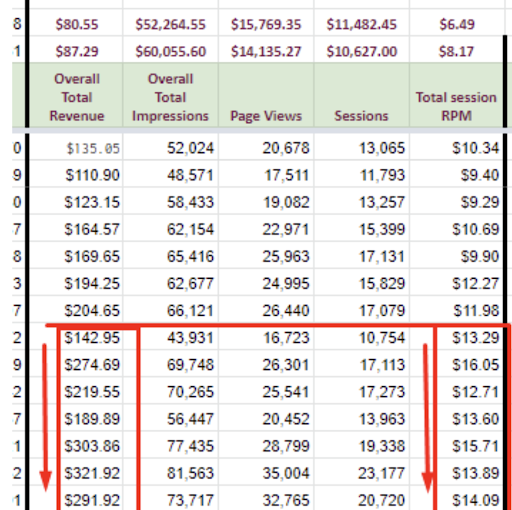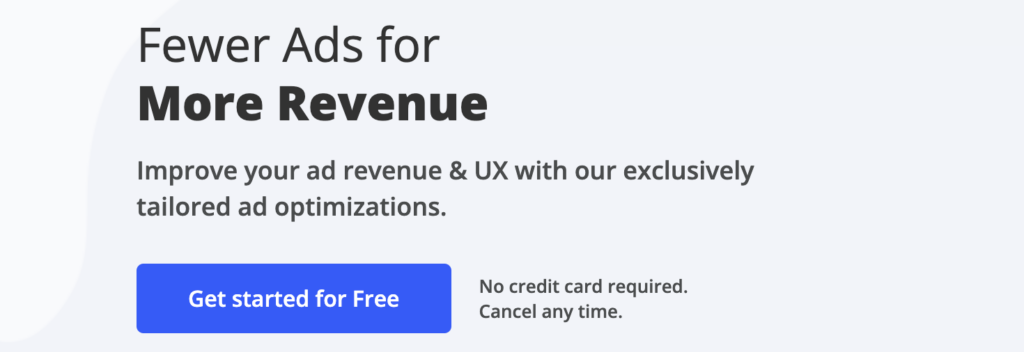Dynamic pricing is all the rage right now in the programmatic world. As more publishers face questions around inventory management and rising eCPMs, they’re looking to dynamic pricing as a solution. Dynamic pricing can give advertisers a better deal on inventory, while also giving publishers more revenue. However, choosing the right platform for your dynamic price floors means a lot more than just the price floor you choose. The benefits are clear: better budget management, increased yield and revenue and reduced time spend managing your marketplace.
This article breaks down why should you choose a dynamic price floor solution and how MonetizeMore’s dynamic floors stand out in the publishers’ marketplace.
Price Floor Optimization
Dynamic Price Floor Optimization is the process of selling ads that involve setting a base price for the publisher’s ad inventory and then automatically fine-tuning the price for maximum yield.
Compared to static price floors, this bad boy fuses multiple advantages:
- Uses historical data (demand bid data) of demand partners while automatically adjusting the price floors every minute.
- Publishers ensure that the SSPs bid a base price depending on the earlier offers.
- Furthermore, dynamic floor pricing increases the price of a publisher’s inventory based on the inventory’s placement, ad size, etc.
Let’s say, your video ads have over a 75% viewability rate, our dynamic floor algorithm adjusts the price floors based on user browsing history, cookies, etc. When a browser has more cookies, it can provide better tracking capabilities for buyers who are willing to spend more for users with more LTV (lifetime value). With MonetizeMore’s Dynamic pricing floor automation, you save time and gain more insight into your data.
Dynamic Price Floor Optimization: Key Benefits

- More ad revenue for publishers
- All-in-one price floor solution from Prebid to Google AdX
- Real-time optimization of price floors based on browsing behavior, seasonality, user segmentation, etc.
- Balances out bid shading.
- Time-saving as the optimization calculations are automated.
- Better content and ad quality.
- You get the best price for your inventory.
Seek Transparency to Challenge Competition
With Dynamic Floors, we are able to communicate price floors to all connected marketplaces as part of the bid request.
Consider the following scenarios to understand how this affects profitability:
1- Conventional Header Bidding Price Floors
Let’s say the floor price is set to $2 in Google Ad Manager.
The price floor set in Google Ad Manager is not visible to all SSPs connected in Header Bidding, so publishers selling ads in Header Bidding may receive a bid of $2.5 through Prebid. The winning bid is then sent to Google. In parallel, Google Ad Manager can bid based on the $2 floor price and can hike it up to $2.5. In this case, Google gains the advantage until its bidding algorithms reach the floor level, penalizing the SSPs connected to Prebid.
2- MonetizeMore’s Dynamic Price Floors Used in PubGuru Header Bidding
MonetizeMore’s dynamic price floor technology sets a price floor depending on a variety of factors. Once it’s set, the data is shared to the SSPs via Prebid.
In this case, the SSPs will bid $2.5 if the floor price is set at $2. Google Ad Manager will then outbid at $2.6 if interested in this winning bid. Here, publishers receive bids at $2.6 than $2.5 since Prebid is competing against Google.
Be more profitable—by using dynamic price floors

1. Better Ad Revenue
Dynamic price floors equal more ad earnings as it adjusts bids depending on historical data, day, time, seasonality, etc.
Ad performance optimization shouldn’t be just about improving eCPMs. You need to focus on the session RPMs (revenue per thousand milles) and page RPMs as well. High base prices will increase eCPMs but also result in more unsold rates.
Deploying automated price floor solutions means improved ad yield.
2. Save Time and Resources
Dynamic price floors allow you to maximize your ad spend. They’re easy to implement, so you can focus on other priorities this season.
Save time and money with this plug & play tool that connects to your existing ad stack. It is compatible with any ad server, so there’s minimal setup. You can save more time to focus on the core elements of your business like content creation.
3. Granular Optimization
Dynamic price floors allow the seller to adjust prices based on how each impression performs, ensuring ads with a high rate of conversion get shown more often and those that don’t get shown as often. This type of pricing model allows for optimization not only on a campaign level but also on an individual ad level.
4. Overall Improved User Experience
A major advantage of the dynamic price floor is that it encourages brands to buy more (or all) of an inventory’s impressions. Because they know that they’re competing against other advertisers with similar budgets, they’re willing to spend more per impression compared to when they’re bidding in an open exchange or through a CPM network.
The result is an enhanced user experience through more sophisticated creatives and a reduction in long-tail advertisers’ access to inventory, who might be less well known.
5. Best Price for your ad inventory
You may know a bit about Bid Shading which is the buy-side programmatic market’s price floor strategy designed to minimize CPMs that extracts the lowest price from which SSPs can win bids.
Bidders are keen on looking for the lowest prices in order to get the maximum ROI. In contrast, bid shading reduces profits for publishers, while dynamic floor pricing encourages buyers to increase prices to regain lost value. That’s how dynamic floors stop inventory value depreciation.
The prices reflect the real value of your ad space, stopping advertisers from bidding below the minimum base price that has been set. It’s a win-win situation as publishers get improved user experience and more ad revenue.
Our Dynamic floors solution has delivered outstanding results for 1000+ publishers and the technology is only getting better each quarter. Contact us today to get started
Watch Your Session RPMs and eCPMs Increase
The Dynamic Floors implemented by our AdOps experts have increased session RPMs from $10 to $14. Here are the results we observed on a specific ad placement:

Other publishers have also seen a steady improvement in their RPMs and eCPMs:
– The ad eCPM has increased from 1.6 to 1.8.
– The total page RPM increased by 1%
– The total session RPM increased by 2%.
Dynamic floor price optimization allows you to take advantage of different opportunities throughout the year by adapting to changing market conditions. MonetizeMore’s Dynamic floor technology takes all this to the next level, as it amplifies the level of competition between Prebid, Amazon, and Google Ad Exchange.
Ready to setup your Dynamic Floors and scale your RPMs? Let’s talk!
source https://www.monetizemore.com/blog/dynamic-floors



0 Comments